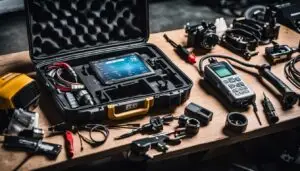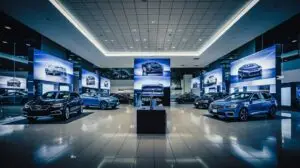You just spent $25 million on a new, “state-of-the-art” dealership. The exterior is stunning, the tile floors sparkle, the lighting is perfect—and yet, the first thing your customers see when they walk in is a black screen.
No welcome message. No branded content. No service updates. Just a black screen.
Why? Because management didn’t want to spend $99/month on a simple digital signage subscription. Let that sink in.

Key Takeways
- Priorities Speak Louder Than Words -Saying you care about customers means nothing if your actions don’t show it.
- Mindset Matters More Than Money – The problem isn’t cost—it’s a lack of intentional leadership.
- Experience Is the New Differentiator -A polished showroom means nothing without meaningful customer touchpoints.
- Small Fixes Create Big Results – Simple changes can drive powerful outcomes.
Table of Contents
ToggleThis Is Dealership Garbage
Dealers constantly say they “care about the customer experience.” It’s in the marketing, the mission statements, and the sales pitches. But when you follow the money, the story changes. You’ll often see $500/month allocated to coffee service—because it’s a self-serving expense that makes leadership feel good without truly impacting the customer journey.
Even better? The GM still walks around with an $8 Starbucks in hand because “his barista makes it better.” The irony writes itself. It’s not about what the customer wants or needs—it’s about personal preferences and appearances.
Meanwhile, the digital displays that could be used to welcome guests, share valuable information, and elevate the overall showroom vibe sit dark and dusty. Black screens meant to engage, inform, and build trust are now just expensive wall decor. Forgotten, overlooked, and ultimately, dealership garbage.
It’s a perfect example of misplaced priorities—spending on convenience over impact, style over substance.
The Issue Isn’t Money—It’s Mindset

Let’s be clear: this isn’t about affording $99/month. If you’re spending millions on a showroom, the issue isn’t budget—it’s mindset.
Too often, leadership prioritizes optics over substance, treating a new building as the finish line instead of the starting point. Screens off, vibes off—and yes, everyone notices. Customers, staff, and competitors can all feel the disconnect when experience takes a backseat to appearance.
When the excitement fades, what’s left? A shiny space with a stagnant atmosphere and disengaged employees. Customers want more than aesthetics—they want to feel seen, valued, and connected.
That takes intentional culture. One that fosters feedback, empowers employees, and encourages continuous improvement. It’s not just about building something beautiful; it’s about filling it with meaning, purpose, and momentum.
Because in the end, what you create matters more than what you build.
It’s 2025. Time to Act Like It.

We’re in an era where every touchpoint matters and customer expectations are higher than ever. Yet many dealers are still stuck in outdated habits—complaining about leads, the economy, tariffs—anything to avoid accountability.
Here’s a thought: instead of complaining, fix the little things that lead to big results.
- Want more leads? Start by creating an in-store experience worth talking about.
- Want better retention? Show customers that you invest in the little details.
- Want your staff more engaged? Build an environment they’re proud to work in.
This is the bare minimum. It’s low-hanging fruit. And yet, it’s so often ignored.
Conclusion
At the end of the day, if your showroom screens are still black, it’s a clear sign your priorities are misaligned. You can’t claim to care about the customer experience while ignoring the small, visible details that shape it. Investing in your in-store environment doesn’t require massive budgets—just intentional leadership. These small, consistent efforts create a ripple effect: they boost customer engagement, elevate employee morale, and ultimately drive better results across the board. It’s 2025. Excuses don’t cut it anymore. The dealerships that win are the ones that stop talking and start fixing.
FAQ’s
1. Why is digital signage such a big deal in a modern dealership?
Because it’s the first impression. It sets the tone, communicates key info, builds trust, and shows customers you care about their experience from the moment they walk in.
2. Can’t we just focus on great sales staff instead of tech upgrades?
Great staff are critical—but they need the right environment to thrive. Tools like digital signage support them by enhancing communication, brand presence, and the overall showroom vibe.
3. We already spent millions on the building—why spend more?
Because the investment isn’t finished when the doors open. A showroom without strategy is just a shell. It’s the ongoing, intentional touches that turn a nice building into a great experience.
4. What’s the harm in leaving the screens off?
It sends the wrong message. Blank screens look lazy and forgotten. If you can’t manage the small stuff, customers (and staff) will wonder what else you’re neglecting.
5. What should we prioritize to improve the in-store experience?
Start with the basics: clear signage, live content, team training, and atmosphere. Focus on details that show customers they’re valued—not just sold to.

Todd Katcher is the Chief Product Officer of Digital Dealership System, a leader of in-store digital signage and real-time performance leaderboards for car dealerships. With a deep understanding of automotive marketing, KPI tracking, and dealership operations, Todd helps dealerships nationwide increase profits through data-driven strategies and engaging digital experiences.







